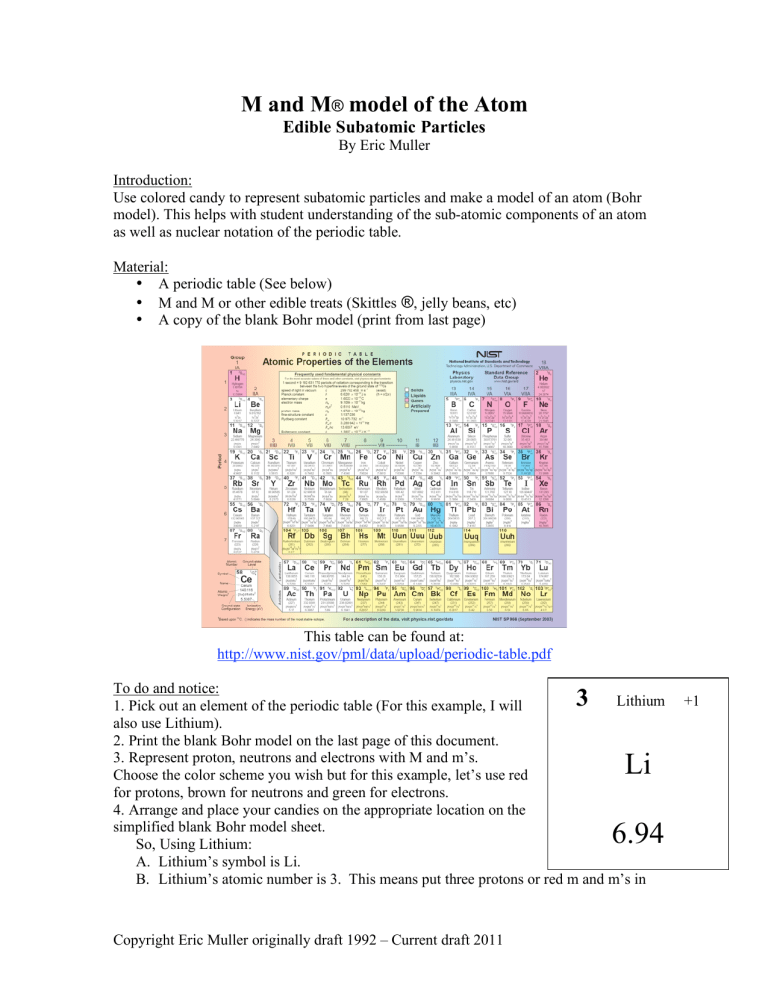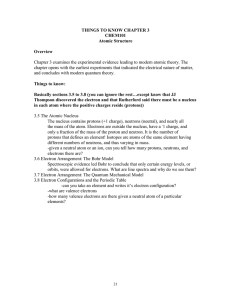
M and M® model of the Atom Edible Subatomic Particles By Eric Muller Introduction: Use colored candy to represent subatomic particles and make a model of an atom (Bohr model). This helps with student understanding of the sub-atomic components of an atom as well as nuclear notation of the periodic table. Material: • A periodic table (See below) • M and M or other edible treats (Skittles ®, jelly beans, etc) • A copy of the blank Bohr model (print from last page) This table can be found at: http://www.nist.gov/pml/data/upload/periodic-table.pdf To do and notice: Lithium 1. Pick out an element of the periodic table (For this example, I will also use Lithium). 2. Print the blank Bohr model on the last page of this document. 3. Represent proton, neutrons and electrons with M and m’s. Choose the color scheme you wish but for this example, let’s use red for protons, brown for neutrons and green for electrons. 4. Arrange and place your candies on the appropriate location on the simplified blank Bohr model sheet. So, Using Lithium: A. Lithium’s symbol is Li. B. Lithium’s atomic number is 3. This means put three protons or red m and m’s in 3 Li 6.94 Copyright Eric Muller originally draft 1992 – Current draft 2011 +1 the center or the nucleus model. C. Lithium’s atomic weight is 6.94 or. Hoever, it rounds off to 7. Since protons and neutrons have a mass of one each, and since we know that Li has 3 protons, this means that Li has 4 neutrons (3 + 4 = 7). Mix in 4 brown m and m’s into the nucleus’s 3 protons. D. Since protons are positively charged particles and since Lithium has 3 protons in the nucleus, it has to have 3 negatively charged particles to make a neutrally charged atom. So, place 3 electrons (negatively) or 3 green m and m’s around the rings around the nucleus. Going further: If you want to organize the electrons into the shells of Lithium, place 2 electrons in the inner most ring (first ring outside of the nucleus) and 1 in the next ring. To learn more about electron shell see resources below. If you want to see how Lithium becomes a positively charged ion , just remove one of the electrons. See additional resource for how atoms become ions. Additional resources: Printable Periodic table: http://www.nist.gov/pml/data/periodic.cfm Element notation: http://hyperphysics.phy-astr.gsu.edu/hbase/nuclear/nucnot.html Electron shells: http://en.wikipedia.org/wiki/Electron_shell Electron configuration: http://en.wikipedia.org/wiki/Electron_configuration Ions and atoms: http://www.chem4kids.com/files/atom_ions.html Copyright Eric Muller originally draft 1992 – Current draft 2011 M and M Model of an Atom Electron Shell 8 max Electron Shell 8 max Electron Shell 2 max Nucleus Copyright Eric Muller originally draft 1992 – Current draft 2011



